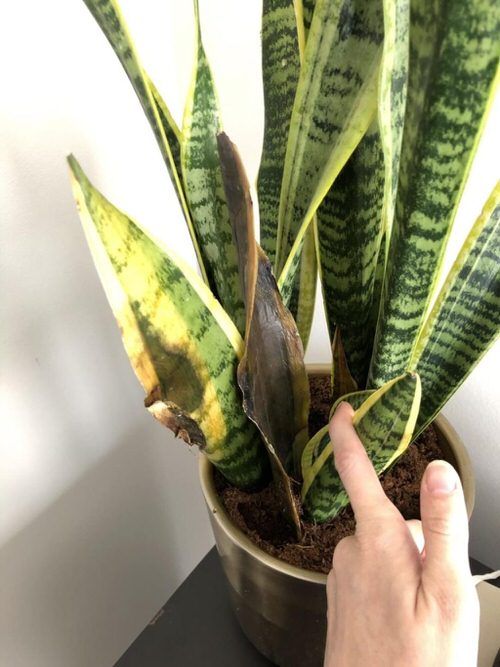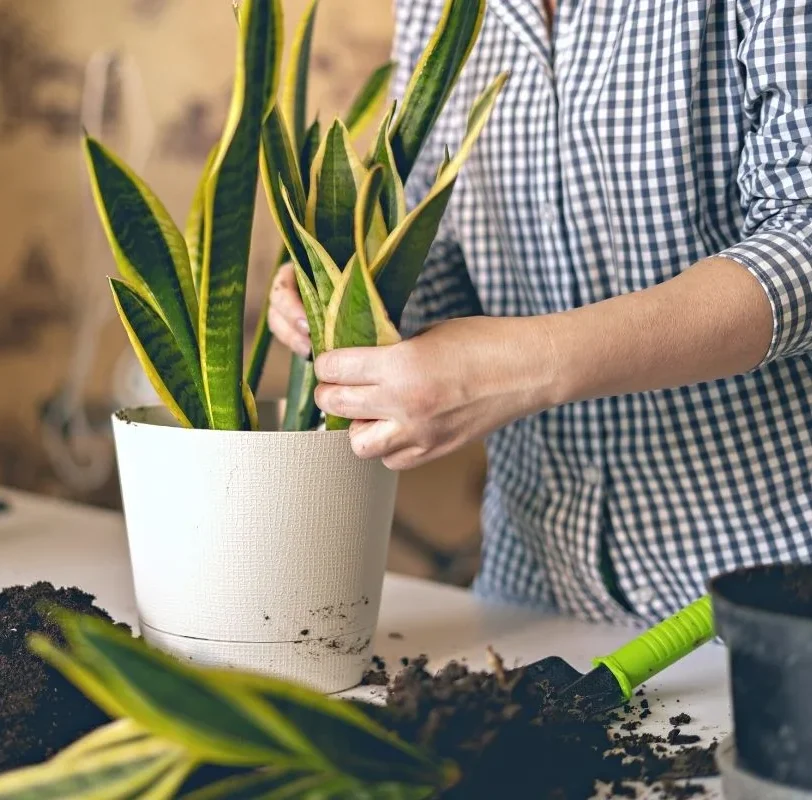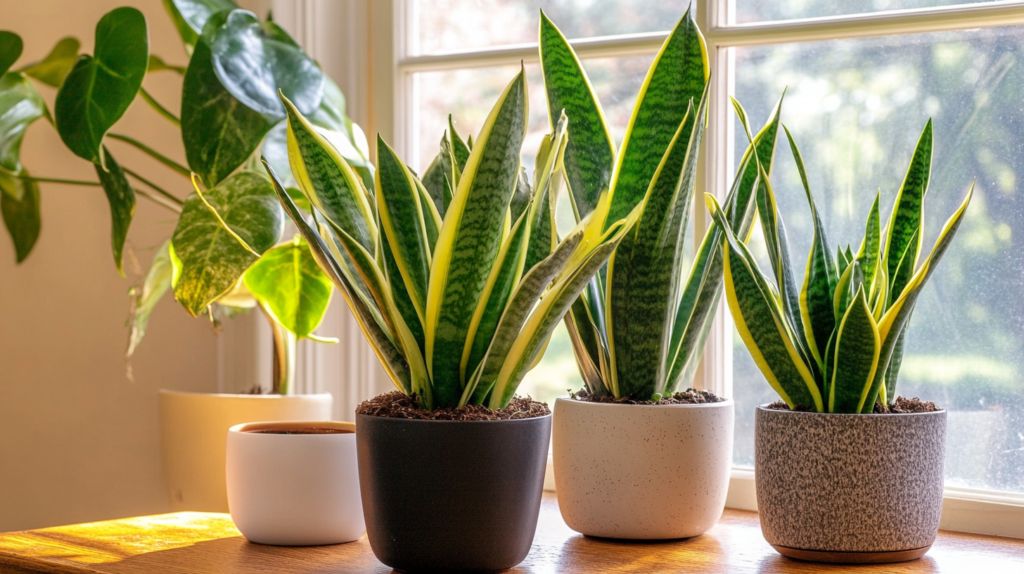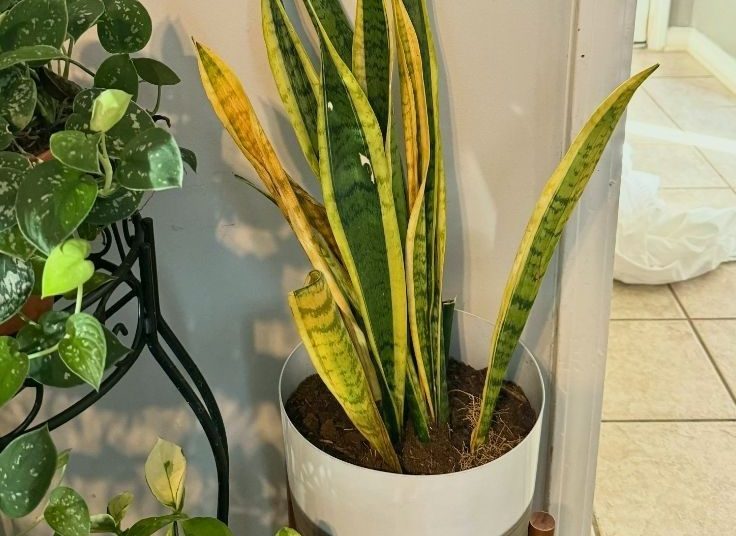Snake plants (Sansevieria), also called mother-in-law’s tongue, are known as one of the easiest houseplants to care for. But even the toughest plants can run into trouble. If you’re asking, “Why is my snake plant dying?”, the answer usually lies in water, soil, or light conditions.
This guide covers the 7 most common reasons snake plants die and the steps you can take to bring yours back to life.
7 Common Reasons & Fixes
1. Overwatering – The #1 Snake Plant Killer
The biggest reason snake plants decline is too much water. Their thick, fleshy leaves store moisture, so they don’t need frequent watering. When the soil stays soggy, the roots suffocate and begin to rot.
Signs of overwatering:
- Mushy, soft leaves
- Snake plant leaves are turning yellow
- Foul odor from the soil
- Soil that feels constantly damp
Solution:
- Let the soil dry out completely before watering again.
- Repot in fresh, well-draining soil if roots are rotting.
- Use a pot with drainage holes.

2. Underwatering – Dry and Wrinkled Leaves
While snake plants are drought-tolerant, neglecting them for too long can cause stress.
Signs of underwatering:
- Wrinkled, shriveled leaves
- Brown leaf tips
- Soil is pulling away from the edges of the pot
Solution:
- Water deeply, allowing excess water to drain out.
- Establish a watering routine based on your climate (every 2–4 weeks, depending on season).
3. Poor Soil or Wrong Pot
Snake plants hate compact, moisture-retaining soil. If your plant sits in dense dirt, its roots will suffocate.
Solution:
- Use a cactus or succulent mix, or make your own with potting soil, perlite, and sand.
- Choose a pot that isn’t too large—extra soil retains water and increases rot risk.

4. Not Enough Light
Snake plants tolerate low light, but they don’t thrive in dark corners forever.
Signs of low light stress:
- Slower growth
- Leaves losing color or turning pale
- Leaning or drooping toward a light source
Solution:
- Place near bright, indirect light for best growth.
- Rotate your plant occasionally for even exposure.
5. Pest Infestations
Though uncommon, pests like mealybugs and spider mites can weaken snake plants by sucking their sap.
Signs of pests:
- Sticky residue on leaves
- Tiny webs or cotton-like clusters
- Yellowing or deformed leaves
Solution:
- Wipe leaves with a damp cloth or neem oil spray.
- Isolate the plant until pests are gone.
6. Temperature and Draft Stress
Snake plants prefer stable conditions. Sudden temperature changes or exposure to cold drafts can cause leaf damage.
Solution:
- Keep them in temperatures between 60–85°F (16–29°C).
- Avoid placing them near heaters, air conditioners, or drafty windows.

7. Root Bound Issues
Over time, snake plants can outgrow their pots. Tightly packed roots may prevent water absorption.
Solution:
- Check roots every 2–3 years.
- Repot into a slightly larger container when roots circle the pot.
How to Revive a Dying Snake Plant
- Inspect the roots — trim away rot and repot in fresh, dry soil.
- Adjust watering — follow the “soak and dry” method.
- Provide proper light — bright, indirect light is ideal.
- Cut off damaged leaves — this directs energy to healthy growth.
- Be patient — snake plants are resilient and often recover with time.

FAQs About Dying Snake Plants
1. How do you save a dying snake plant?
A dying snake plant can often be saved by removing rotting roots, repotting into well-draining soil, reducing watering, and providing bright, indirect light.
2. What does an overwatered snake plant look like?
Overwatered snake plants usually have mushy, yellow leaves and soggy soil. In severe cases, leaves collapse at the base due to root rot.
3. Why is my snake plant turning yellow and soft?
Yellow, soft leaves are a classic sign of overwatering and root rot. Trim damaged leaves and repot in dry, gritty soil to help the plant recover.
4. Can a snake plant come back from root rot?
Yes, but only if some healthy roots remain. Cut away rotting roots, repot into fresh soil, and allow the plant to dry between waterings.
5. Why is my snake plant drooping even though I didn’t overwater?
Drooping can also happen due to low light, poor soil drainage, pests, or sudden temperature changes.
Final Thoughts
If your snake plant looks like it’s dying, don’t panic. Most issues come down to water, light, or soil problems—and these are easy to fix once you know what to look for. By adjusting your care routine and giving your plant the right environment, you can revive it and enjoy its hardy beauty for years to come.
















